Knowde Enhanced TDS
Identification & Functionality
- INCI Name
- Ingredient Origin
- Cosmetic Ingredients Functions
- CAS No.
- 283602-75-5
- Technologies
- Product Families
Features & Benefits
- Benefit Claims
- Labeling Claims
- Product Background
The pollutants which constitute our daily, inside and outside environment, must be rightly considered as important sources of cutaneous stresses, even if they were underestimated for a long time. The evolution of our lifestyles and the increasing urbanization during these past years amplify the risks, making the pollution one of the major sources of concern for the health and beauty. Cells, their lipid and protein components but also their DNA are the targets of pollutants, generators of oxidation and inflammation. Dry skin, reactive and sensitive skin, acne and more particularly premature and accelerated aging are so many consequences known for the pollution. It is their nature which determines the degree of penetration and damages of pollutants but also the integrity of the Stratum corneum. Unfortunately its protective function is not unlimited and the prolonged and repetitive exposure to high levels of pollutants overtakes its natural defense capacity, until the barrier weakened and the damages increase. If biologically stimulating the natural defenses is an answer to fight against pollution at long term, it is also possible to act immediately and physically, to increase the skin capacity of protection by applying a «breathing» shield, which like a second skin will make screen for the penetration of pollutants and reduce the induced damages.
Applications & Uses
- Markets
- Applications
- Skin Care Applications
- Formulation Guidelines
pH stability: 3.0 to 9.0
Thermostability: incorporation at high or low temperature
Soluble in water, glycerin, glycol, 20% ethanolic solution
Pollustop® interacts positively with salts, glycols, alcohol, PEG. To form organized gelled structures, thereby increasing its matrix effect and texturizing properties
- Recommended Uses
- Everyday protective skin and hair care
- Anti-pollution
- Anti-aging
- Sun care
- Formulation with residual film
Properties
- Physical Form
Regulatory & Compliance
- Certifications & Compliance
- Regulatory Status
Authorized to use in EU, USA, China ( IECIC 2015, IECSC), Japan, and conditional in Canada and Australia.
Technical Details & Test Data
- Performance Characteristics
PROTECTION AGAINST ATMOSPHERIC POLLUTION
1. CARBON PARTICLES (149µm)
In vivo study On 10 volunteers application of a cream containing Glycofilm® 1.5P (or Pollustop®) (1%, 3% and 5%) vs. Placebo and then a carbon particles solution / Visualization by videomicroscopy and quantification by image analysis before and after rinsing
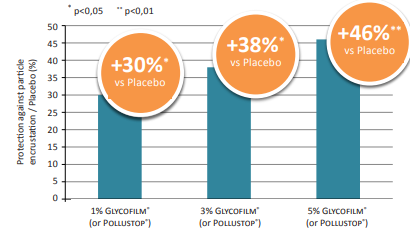
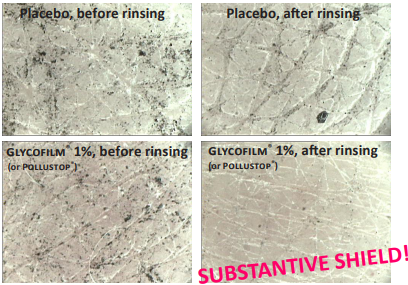
Result: Significant protection against the carbon particles encrustation on the skin: skin could breath!
2. PARTICULATE MATTER (PM2.5)
In vitro studies On reconstructed epidermis treatment by topical application of Glycofilm® 1.5P (or Pollustop®) at 1% and 3% in an aqueous solution vs. untreated control / Exposed to non cytotoxic dose of PM2.5 (4.375 mg/ ml in dichloromethane) during 18 hours / Intracellular oxidative stress is revealed by dichlorofluoresceine and measured by fluorimeter
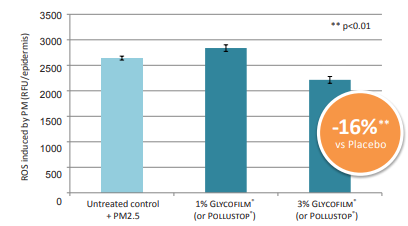
On reconstructed epidermis treatment by topical application of Glycofilm® 1.5P (or Pollustop®) at 1% and 3% in an aqueous solution vs. untreated control / Exposed to cytotoxic dose of PM2.5 (10.5 mg/ml in dichloromethane) during 48 hours / Lipid peroxidation is revealed by MDA level measured by TBARs test and spectrophotometer.
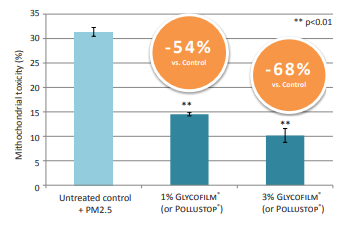
On reconstructed epidermis treatment by topical application of Glycofilm® 1.5P (or Pollustop®) at 1% and 3% in an aqueous solution vs. untreated control / Exposed to cytotoxic dose of PM2.5 (10.5 mg/ml in dichloromethane) during 48 hours / Mitochondrial toxicity was evaluated by MTT test and measured by spectrophotometer.
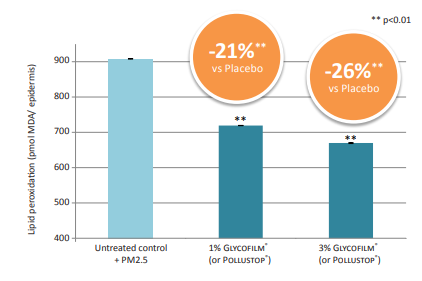
Result: Significant protection against PM2.5 damages, e.g. intracellular oxidative stress, mitochondrial toxicity and lipid peroxidation.
3. HEAVY METALS
In vivo study On 20 smokers, strippings were performed on cheeks / Topical application on hemi-face of a cream containing 3% Glycofilm® 1.5P (or Pollustop®) and Placebo / Volunteers were asked to spend 6h outside in a city area (atmospheric pollution >50µg of particles/m3 ) and smoked at least 5 cigarettes / At T6h, new strippings were performed / Assay of heavy metals.

Result: Huge barrier effect against heavy metals deposition! More than 95% of deposition limitation vs. Placebo (p<0.001)
PROTECTION AGAINST UV
1. ON SKIN
In vitro study On reconstructed epidermis topical application of Glycofilm® 1.5P (or Pollustop®) at 5% vs. Control / UV irradiation / Viability evaluated by dosage of lactate deshydrogenase (enzyme testifying of membrane alteration) and of IL1-α released in culture medium (Elisa kit) / Coloring, visualization on histological section and enumeration of Sun Burn Cells.
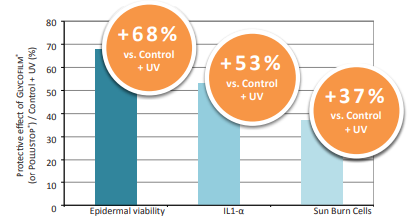
Result: Significant increase of cell viability & Significant preservation from UV-induced inflammation
2. OPTIMIZATION OF SOLAR PROTECTION
In vivo study On 10 volunteers application on back of creams containing Glycofilm® 1.5P (or Pollustop®) (3 and 5%) associated or not to matrix co-activators (NaCl, PEG-8) vs Placebo / UV irradiation / Evaluation and measure of Glycofilm® 1.5P (or Pollustop®) interactivity via the SPF (Solar Protection Factor) calculation.
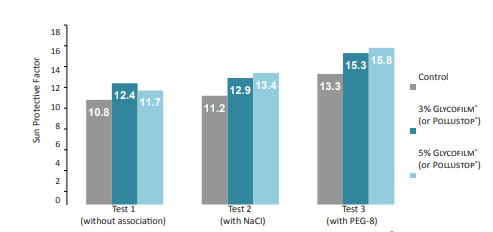

Results: Boosts SPF: +1 to 3 points & Great interactivity allowing to form a well organized structure: matrix effect amplified + texture benefits!
3. ON HAIR
Ex vivo study On hair locks topical application of Glycofilm® 1.5P (or Pollustop®) at 1% / Incorporation of a fluorescent labeling and irradiation of hair locks (UVA-UVB) / Measure by fluorescence of the free radicals produced
Results: +76% of anti-free radicals efficacy
PROTECTION AGAINST DOMESTIC POLLUTION
SULFATES USED IN HYGIENE/HOUSEHOLD PRODUCTS
Ex vivo study On reconstructed epidermis topical application of Glycofilm® 1.5P (or Pollustop®) at 5% vs Control / Treatment with a solution of 8% SDS (Sodium Dodecyl Sulfate) / Viability evaluated by spectrophotometric assay of lactate deshydrogenase.
Result: +37% of protection against SDS-induced cell toxicity
- Mechanism of Action
Thanks to its matrix-forming property, Glycofilm®/ Pollustop® makes barrier to the 3 types of pollution stresses:
- Atmospheric (carbon particles, particulate matter and heavy metals)
- UV
- Domestic (chemicals) and so limit the extra and intracellular induced damages: oxidative stress, inflammation, cellular and mitochondrial toxicity.